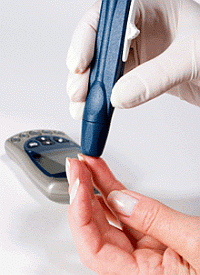Biomedical engineers at North Carolina State University in Raleigh developed a system of long-term insulin delivery for patients with diabetes, which tests in lab animals show can regulate blood glucose levels without painful injections. The team led by NC State engineering professor Zhen Gu published its findings online earlier this week in the journal Advanced Healthcare Materials (paid subscription required).
Gu, with colleagues from NC State and Yangzhou University in China, devised the system from biocompatible nanoscale particles, made from polylactic-co-glycolic acid or PLGA, a biodegradable polymer used in medical applications. The nanoparticles are then coated with natural materials, either chitosan found in shrimp shells or alginate from seaweed, and filled with insulin.
The chitosan coating has a positive charge, while alginate coatings have a negative charge. When the particles are mixed together in a solution, the particles with different charged coatings are attracted to each other, and bind together in an electrostatic network. The network is strong enough to hold together when the nanoparticles are injected just under the skin.
While the nanoparticles are porous, the insulin in the particles does not go far on its own, because of the electrostatic force of the network, thus forming a pool of insulin at the site of the nanoparticle network. But when exposed to ultrasound, the waves appear to excite the particles, relaxing the electrostatic force holding together the network, and allowing the insulin to enter the bloodstream. When the ultrasound is removed and the waves subside, residual insulin in the particles refills the pool, replacing the insulin delivered earlier into the blood.
Tests with lab mice provided a proof of the NC State team’s concept. “We found that this technique achieves a quick release of insulin into the bloodstream,” says Gu in a university statement, “and that the nano-networks contain enough insulin to regulate blood glucose levels for up to 10 days.”
When the insulin runs out, say the researchers, the old network of nanoparticles is absorbed into the body, since the particles are made from biocompatible and biodegradable materials. A new batch of insulin-filled nanoparticles then replaces the old network.
Read more:
- Grant to Fund Glucose-Sensitive Insulin Development
- Small Business Grant Awarded for Artificial Pancreas Insulin
- New Methods Found to Better Monitor Glucose, Control Insulin
- FDA Approves Touch-Screen Insulin Pump System
- Trial of Insulin-Coated Gold Nanoparticles Approved
* * *


 RSS - Posts
RSS - Posts
You must be logged in to post a comment.